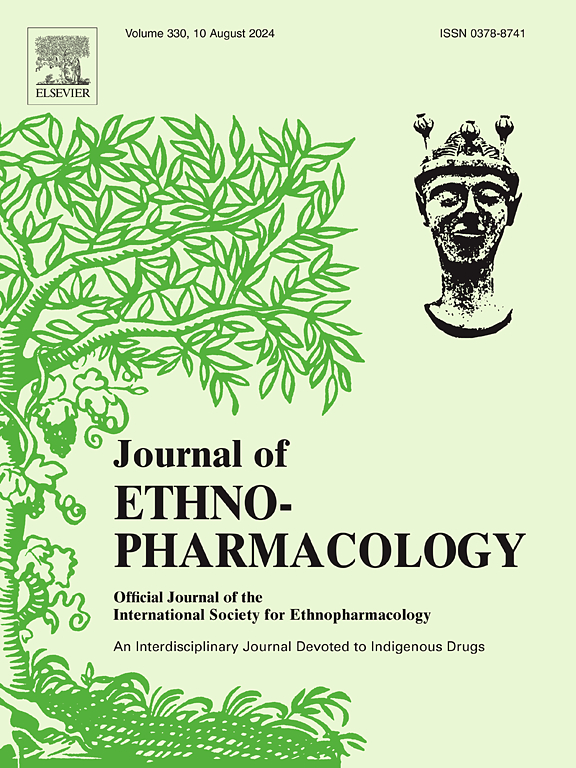IF 4.8
2区 医学
Q1 CHEMISTRY, MEDICINAL
引用次数: 0
摘要
民族药理学相关性天麻和黄柏(AP)是一种用于治疗抑郁症的协同药物组合。方法通过慢性不可预知的轻度应激(CUMS)建立抑郁症模型,并用不同剂量的 AP 治疗。采用UPLC-Q-TOF-MS/MS和网络药理学方法分析AP的成分和潜在靶点。分子对接、亲和超滤(AUF)和细胞热转移试验(CETSA)技术用于分析 AP 成分与关键靶点之间的相互作用。结果AP能改善CUMS诱导的绝望行为,调节小胶质细胞的M1/M2表型平衡,减少神经炎症。然后,在 CUMS 大鼠的 mPFC 中发现了 10 种大脑成分。根据这些化学成分,通过网络分析发现PTGS2处于调控网络的核心。AP的所有成分都与PTGS2有良好的相互作用,其中新莽草素与PTGS2的结合能力最强。AP能降低PTGS2的活性,减少下游PGE2的产生和EP2的表达,减轻炎症反应。在LPS诱导的BV2细胞中,新芒果素能调节M1/M2小胶质细胞的失衡,减少促炎因子的释放,降低PTGS2、PEG2、EP2、cAMP和Epac1的表达。本文章由计算机程序翻译,如有差异,请以英文原文为准。

Anemarrhena asphodeloides Bunge and Phellodendri Chinensis Cortex inhibits the PTGS2/EP2/cAMP/Epac1 signaling pathway to reduce microglial M1 polarization, thereby blocking chronic stress-induced depression-like behavior
Ethnopharmacological relevance
Anemarrhena asphodeloides Bunge and Phellodendri Chinensis Cortex (AP) is a synergistic drug combination used to treat depression. However, the molecular mechanism underlying the therapeuticeffects of AP requires further elucidation.
Aim of the study
To investigate the potential of AP in the treatment of depression and its mechanism of action.
Methods and methods
The depression model was established by chronic unpredictable mild stress (CUMS) and treated with different doses of AP. UPLC-Q-TOF-MS/MS and network pharmacology methods were used to analyze the composition and potential targets of AP. Molecular docking, affinity ultrafiltration (AUF) and cellular thermal shift assays (CETSA) techniques were used to analyze the interaction between AP components and key targets. The therapeutic effects of AP active ingredients were explored in LPS-induced cell models.
Results
AP ameliorated CUMS-induced despair behaviors, regulate M1/M2 phenotypic balance of microglia and reduced neuroinflammation. Then, A total of 10 brain components were identified in the mPFC of CUMS rats. Based on these chemical compositions, PTGS2 was found to be at the core of the regulatory network through network analysis. All components of AP had good interaction with PTGS2, among which Neomangiferin and PTGS2 had the strongest binding capacity. AP can decrease PTGS2 activity, decrease PGE2 production and EP2 expression downstream, and reduce inflammatory response. In LPS-induced BV2 cells, Neomangiferin regulated the imbalance of M1/M2 microglia, reduced the release of pro-inflammatory factors, and decreased the expression of PTGS2, PEG2, EP2, cAMP, and Epac1.
Conclusion
AP improves the potential therapeutic benefits of depression by targeting the PTGS2 signaling pathway, thereby promoting the wider use of AP in depression.
求助全文
通过发布文献求助,成功后即可免费获取论文全文。
去求助
来源期刊

Journal of ethnopharmacology
医学-全科医学与补充医学
CiteScore
10.30
自引率
5.60%
发文量
967
审稿时长
77 days
期刊介绍:
The Journal of Ethnopharmacology is dedicated to the exchange of information and understandings about people''s use of plants, fungi, animals, microorganisms and minerals and their biological and pharmacological effects based on the principles established through international conventions. Early people confronted with illness and disease, discovered a wealth of useful therapeutic agents in the plant and animal kingdoms. The empirical knowledge of these medicinal substances and their toxic potential was passed on by oral tradition and sometimes recorded in herbals and other texts on materia medica. Many valuable drugs of today (e.g., atropine, ephedrine, tubocurarine, digoxin, reserpine) came into use through the study of indigenous remedies. Chemists continue to use plant-derived drugs (e.g., morphine, taxol, physostigmine, quinidine, emetine) as prototypes in their attempts to develop more effective and less toxic medicinals.
 求助内容:
求助内容: 应助结果提醒方式:
应助结果提醒方式:


